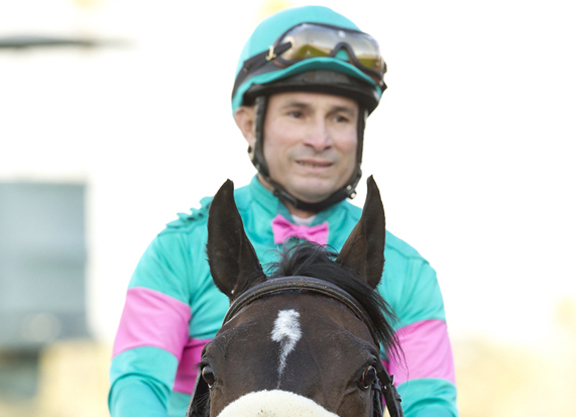By Bill Finley
It should not have come as any surprise that the California Horse Racing Board voted Thursday to change its rules regarding whipping, allowing jockeys to hit their horses more often. After all, this is horse racing, where it's always one step forward, one-point-seven steps backward.
This time, even for this dysfunctional, schizophrenic, we-absolutely-must-shoot-ourselves-in-the-foot sport, the decision by the CHRB was particularly harebrained.
You might not have a problem with the new rule, which will allow jockeys to now hit a horse four times in succession in the final sixteenth of a mile instead of three. But you should have a major issue with the voting process and exactly who was allowed to decide the fate of the rules. In a 4-3 decision, the deciding vote was cast by jockey Alex Solis, who is also a member of the CHRB. Solis is a classy guy and no one has ever questioned his integrity. But he is not only a jockey, he is a jockey who was fined three times for breaking the existing rule. If you are a habitual speeder, always driving 80 in a 65-zone, and have been ticketed three times, they're not going to let you come in and decide to raise the speed limit.
You can argue that Solis, as an active jockey, shouldn't be on the CHRB in the first place. At the very least, he should have recused himself from this vote because of the very obvious conflict of interest. But that would have taken common sense on someone's part, and that's something in short supply in horse racing.
So, with the help of Solis and three other commissioners, the CHRB took something that was progressive and good for the sport and dumped it in the trash can. The obvious reason to tighten, and not loosen, regulations regarding whipping is public perception. Maybe it isn't such a big deal and maybe these new whips don't really hurt the horse. This is one of those rare cases where the facts, whatever they may be, don't matter. People don't like to see animals abused and a lot of people think hitting a horse with a whip, stick, crop, or whatever you want to call it, is cruel. Most people think dog racing is cruel. And look where dog racing is.
Solis said that one of the times he got fined he probably would not have won the race had he not continued to strike the horse. That may or may not be true, but our society is one made up of rules and regulations and, in this case, they are intended to protect the animal and convey an image to the public that horse racing is not abusive. Lines have to be drawn. Was there a race where Solis finished second and might have won if he struck the horse repeatedly with a cat o' nine tails to encourage it to run faster? Absurd? Yes. But where do we draw that line?
Responding to Solis's argument, we found at least one member of the CHRB who gets it.
“That's what upsets me, a horse is tiring and giving out, and we're sitting here encouraging them with a whip, and I think that's cruel,” said Commissioner Steve Beneto. “I'd rather see a jockey lose the race than have somebody abuse the horse.”
Speaking on behalf of the Jockeys' Guild, its western regional manager, Darrell Haire argued that being allowed to strike a horse four times in succession is not abuse. He might want to bring that up with my 15-year-old daughter. Brought up in a family where both parents work in the racing industry, she has zero interest in the sport and when asked why said it is because she doesn't like to watch the jockeys beating the horses.
Making this situation even more preposterous is that the existing rule was apparently working just fine. Scott Chaney, a steward at the Southern California tracks, said the new whipping regulation was a “resounding success.”
I understand I am not a jockey and people I respect, like Chris McCarron, have told me there is a need for a jockey to carry a whip. I'm sorry, I just don't buy it. Whipping should be outright banned, and I'll even, free of charge, tell the sport how to go about it: Start with experimental whip-less races. Don't do it with 2-year-olds or in big races. Take some mid-level claiming races, perhaps on the grass, definitely for older horses, and don't allow the jockeys to carry whips. As an incentive to get trainers and owners to enter, increase the purse by 30%. Let's see what happens and whether whip-less racing works. You can even allow the jockeys to carry whips and allow them to use them only if they feel the need to because of reasonable safety issues involving high-strung or unmanageable horses.
If these races create any problems whatsoever, I'll admit I was wrong.
Whipping horses is something that was established in the stone age, when people cared a lot less about animal rights, cock fighting was legal, no one had ever heard of Michael Vick and when racing had a monopoly on legal gambling. Take the whip away from every jockey and you have a level playing field, the only thing a bettor, owner, trainer and even a jockey, should ask for. The main reason whipping is still allowed is because horse racing has an innate defect, an inability to change with the times. Not that we needed any more evidence, but the CHRB foolishly proved that point once again.
Not a subscriber? Click here to sign up for the daily PDF or alerts.






